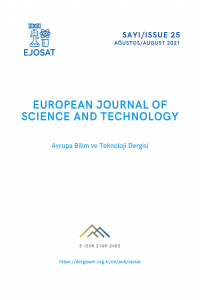Itır (Pelargonium graveolens) Uçucu Yağının FTIR, Raman ve GC-MS Teknikleri Kullanılarak Kimyasal Parmak İzinin Tespit Edilmesi
Abstract
Itır uçucu yağı, keskin gül benzeri kokusu ile gül esansiyel yağının bir çeşit ikamesi olarak bilinir ve en değerli esansiyel yağlardan biridir. Eşsiz kalite özellikleri, sardunya esansiyel yağını gıda endüstrisi uygulamaları için çekici kılmaktadır. Bu çalışma, güçlü titreşim spektroskopisi teknikleri (Fourier dönüşümlü kızılötesi spektroskopisi ve Raman spektroskopisi) kullanarak Itır esansiyel yağının kimyasal parmak izini belirlemiştir. FTIR ve Raman karakterizasyonları, ıtır esansiyel yağının fonksiyonel kimyasal grupları temelinde gerçekleştirilmiştir. Itır uçucu yağının uçucu bileşenlerinin tespiti ve miktarının belirlenmesi için GC-MS (gaz kromatografisi-kütle spektroskopu) tekniği kullanılmıştır. 37 (otuz yedi) uçucu bileşen GC-MS analizi ile belirlenmiştir. Relatif olarak en bol miktarda bulunan bileşikler Citronellol (%30.68), Geraniol (%9.68) ve Citronelly format (%9.90) olarak belirlenmiştir.
Keywords
References
- Agatonovic-Kustrin, S., Ristivojevic, P., Gegechkori, V., Litvinova, T.M., and W. Morton, D. (2020). Essential Oil Quality and Purity Evaluation via FT-IR Spectroscopy and Pattern Recognition Techniques. Appl. Sci., 10, 7294.
- Berechet, M.D., Calinescu, I., Stelescu, M.D., Manaila, E., Craciun, G., Purcareanu, B., Mihaiescu, D.E., Rosca, S., Fudulu, A., Niculescu-Aron, I.G., et al. (2015). Composition of the essential oil of Rosa damascena Mill. cultivated in Romania. Rev. Chim., 66, 1986–1991.
Chemical Fingerprinting of the Geranium (Pelargonium graveolens) Essential Oil by Using FTIR, Raman and GC-MS Techniques
Abstract
Geranium oil is known as a floral substitute of rose essential oil with its pungent rose-like odor and is one of the most valuable essential oils. Favorable quality properties make the geranium essential oil exigible for food industry applications. This study determined the chemical fingerprint of geranium essential oil using robust vibrational spectroscopy techniques (Fourier transform infrared spectroscopy and Raman spectroscopy). The mid-infrared characterization was accomplished on the basis of functional chemical groups of geranium essential oil. GC-MS (gas chromatography-mass spectroscopy) technique was used for the detection and quantification of the volatile constituents of geranium essential oil. 37 (thirty-seven) volatile compounds were determined by the GC-MS analysis. The most abundant compounds were determined as Citronellol (30.68 %), Geraniol (9.68%) and Citronelly formate (9.90%).
Keywords
References
- Agatonovic-Kustrin, S., Ristivojevic, P., Gegechkori, V., Litvinova, T.M., and W. Morton, D. (2020). Essential Oil Quality and Purity Evaluation via FT-IR Spectroscopy and Pattern Recognition Techniques. Appl. Sci., 10, 7294.
- Berechet, M.D., Calinescu, I., Stelescu, M.D., Manaila, E., Craciun, G., Purcareanu, B., Mihaiescu, D.E., Rosca, S., Fudulu, A., Niculescu-Aron, I.G., et al. (2015). Composition of the essential oil of Rosa damascena Mill. cultivated in Romania. Rev. Chim., 66, 1986–1991.
Details
| Primary Language | English |
|---|---|
| Subjects | Engineering |
| Journal Section | Articles |
| Authors | |
| Publication Date | August 31, 2021 |
| Published in Issue | Year 2021 Issue: 25 |


